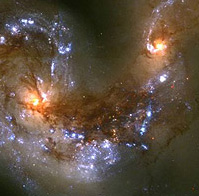Hubble's latest image of the Antennae galaxies
Click on image for full size
NASA
A Natural Fireworks Display
News story originally written on October 24, 1997
It must have looked like something straight out of the movie
Contact. This wasn't a computer graphic though, it was nature's "firework" display. The Hubble Space Telescope has recently uncovered a pair of colliding galaxies. Within the galaxies are over 1,000 brilliant young star clusters.
The images that Hubble has taken are spectacular! What surprised scientists even more than the clarity of the images was the number of young star clusters found in the midst of the colliding Antennae galaxies (called Antennae because of the long wisps of stars that resemble an insect's antennae) .
Dr. Francois Schweizer of the Carnegie Institution said, "This galaxy is an excellent laboratory for studying the formation of stars and star clusters since it is the nearest and youngest example of a pair of colliding galaxies." This is certainly a monumental finding. It is likely to change what we know of star and galaxy formation. It also promises to reveal the future fate of Earth's home, the Milky Way galaxy. The Milky Way will at sometime in the distant future collide into our neighboring Andromeda galaxy.
You might also be interested in:

It was another exciting and frustrating year for the space science program. It seemed that every step forward led to one backwards. Either way, NASA led the way to a great century of discovery. Unfortunately,
...more
The Space Shuttle Discovery lifted off from Kennedy Space Center at 2:19 p.m. EST, October 29th. The sky was clear and the weather was great as Discovery took 8 1/2 minutes to reach orbit for the Unitied
...more
A moon was discovered orbiting the asteroid, Eugenia. This is only the second time in history that a satellite has been seen circling an asteroid. A special mirror allowed scientists to find the moon
...more
Will Russia ever put the service module for the International Space Station in space? NASA officials are demanding an answer from the Russian government. The necessary service module is currently waiting
...more
During a period of about two days in early May, 1998, the ACE spacecraft was immersed in plasma associated with a coronal mass ejection (CME). The SWICS instrument on ACE, which determines unambiguously
...more
J.S. Maini of the Canadian Forest Service has referred to forests as the "heart and lungs of the world." Forests reduce soil erosion, maintain water quality, contribute to atmospheric humidity and cloud
...more
In late April through mid-May 2002, all five naked-eye planets are visible simultaneously in the night sky! This is includes Mercury which is generally very hard to see because of its proximity to the
...more















